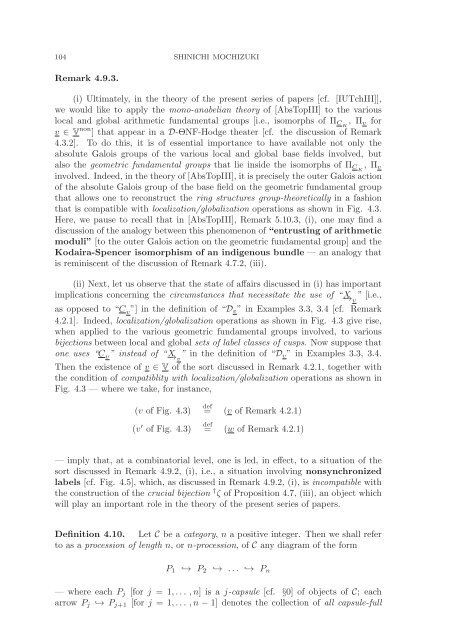Inter-universal Teichmuller Theory I: Construction of Hodge Theaters
Inter-universal Teichmuller Theory I: Construction of Hodge Theaters
Inter-universal Teichmuller Theory I: Construction of Hodge Theaters
You also want an ePaper? Increase the reach of your titles
YUMPU automatically turns print PDFs into web optimized ePapers that Google loves.
104 SHINICHI MOCHIZUKI<br />
Remark 4.9.3.<br />
(i) Ultimately, in the theory <strong>of</strong> the present series <strong>of</strong> papers [cf. [IUTchIII]],<br />
we would like to apply the mono-anabelian theory <strong>of</strong> [AbsTopIII] to the various<br />
local and global arithmetic fundamental groups [i.e., isomorphs <strong>of</strong> Π CK ,Π v for<br />
v ∈ V non ] that appear in a D-ΘNF-<strong>Hodge</strong> theater [cf. the discussion <strong>of</strong> Remark<br />
4.3.2]. To do this, it is <strong>of</strong> essential importance to have available not only the<br />
absolute Galois groups <strong>of</strong> the various local and global base fields involved, but<br />
also the geometric fundamental groups that lie inside the isomorphs <strong>of</strong> Π CK ,Π v<br />
involved. Indeed, in the theory <strong>of</strong> [AbsTopIII], it is precisely the outer Galois action<br />
<strong>of</strong> the absolute Galois group <strong>of</strong> the base field on the geometric fundamental group<br />
that allows one to reconstruct the ring structures group-theoretically in a fashion<br />
that is compatible with localization/globalization operations as shown in Fig. 4.3.<br />
Here, we pause to recall that in [AbsTopIII], Remark 5.10.3, (i), one may find a<br />
discussion <strong>of</strong> the analogy between this phenomenon <strong>of</strong> “entrusting <strong>of</strong> arithmetic<br />
moduli” [to the outer Galois action on the geometric fundamental group] and the<br />
Kodaira-Spencer isomorphism <strong>of</strong> an indigenous bundle — an analogy that<br />
is reminiscent <strong>of</strong> the discussion <strong>of</strong> Remark 4.7.2, (iii).<br />
(ii) Next, let us observe that the state <strong>of</strong> affairs discussed in (i) has important<br />
implications concerning the circumstances that necessitate the use <strong>of</strong> “X −→v ” [i.e.,<br />
as opposed to “C v ”] in the definition <strong>of</strong> “D v ” in Examples 3.3, 3.4 [cf. Remark<br />
4.2.1]. Indeed, localization/globalization operations as shown in Fig. 4.3 give rise,<br />
when applied to the various geometric fundamental groups involved, to various<br />
bijections between local and global sets <strong>of</strong> label classes <strong>of</strong> cusps. Now suppose that<br />
one uses “C v ” instead <strong>of</strong> “X −→v ” in the definition <strong>of</strong> “D v ” in Examples 3.3, 3.4.<br />
Then the existence <strong>of</strong> v ∈ V <strong>of</strong> the sort discussed in Remark 4.2.1, together with<br />
the condition <strong>of</strong> compatiblity with localization/globalization operations as shown in<br />
Fig. 4.3 — where we take, for instance,<br />
(v <strong>of</strong> Fig. 4.3)<br />
(v ′ <strong>of</strong> Fig. 4.3)<br />
def<br />
= (v <strong>of</strong> Remark 4.2.1)<br />
def<br />
= (w <strong>of</strong> Remark 4.2.1)<br />
— imply that, at a combinatorial level, one is led, in effect, to a situation <strong>of</strong> the<br />
sort discussed in Remark 4.9.2, (i), i.e., a situation involving nonsynchronized<br />
labels [cf. Fig. 4.5], which, as discussed in Remark 4.9.2, (i), is incompatible with<br />
the construction <strong>of</strong> the crucial bijection † ζ <strong>of</strong> Proposition 4.7, (iii), an object which<br />
will play an important role in the theory <strong>of</strong> the present series <strong>of</strong> papers.<br />
Definition 4.10. Let C be a category, n a positive integer. Then we shall refer<br />
to as a procession <strong>of</strong> length n, orn-procession, <strong>of</strong>C any diagram <strong>of</strong> the form<br />
P 1 ↩→ P 2 ↩→ ... ↩→ P n<br />
—whereeachP j [for j =1,... ,n]isaj-capsule [cf. §0] <strong>of</strong> objects <strong>of</strong> C; each<br />
arrow P j ↩→ P j+1 [for j =1,... ,n− 1] denotes the collection <strong>of</strong> all capsule-full
















